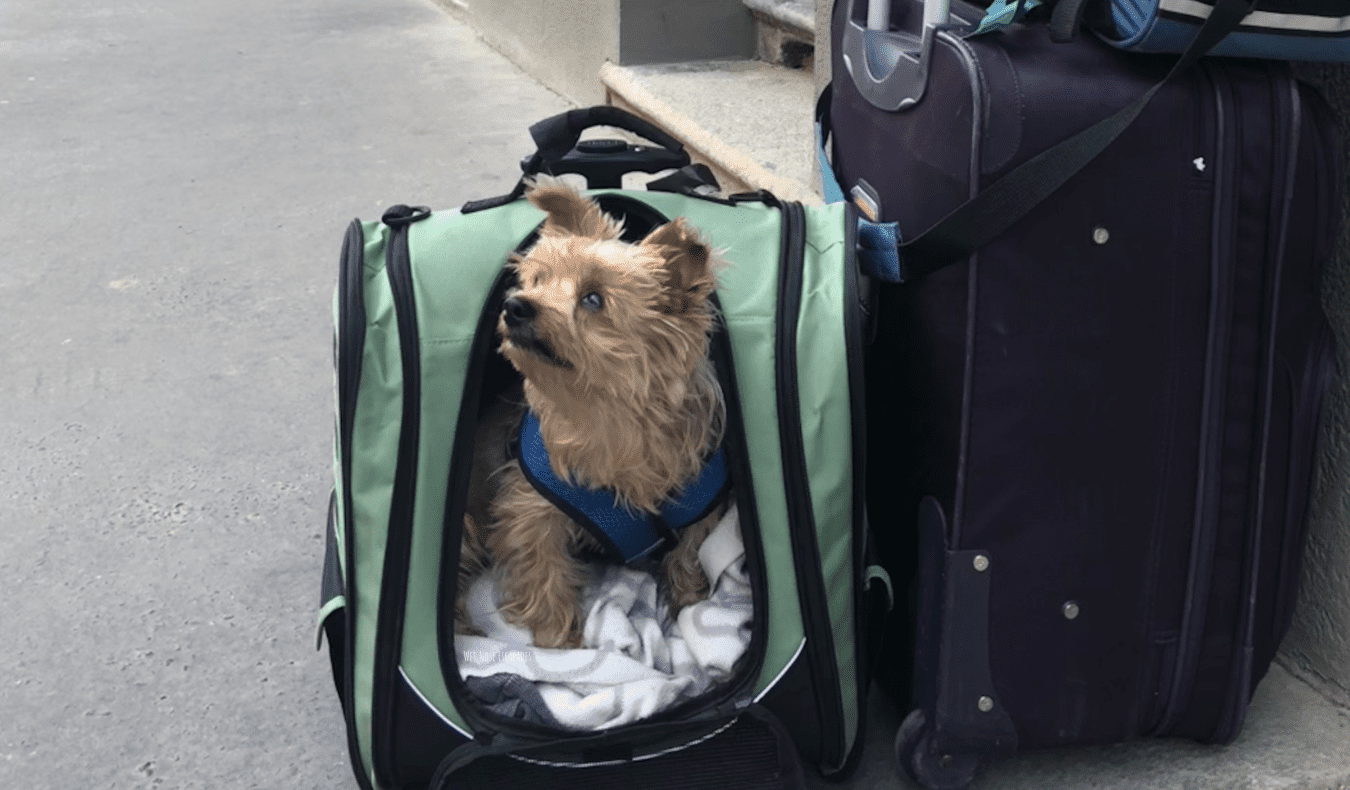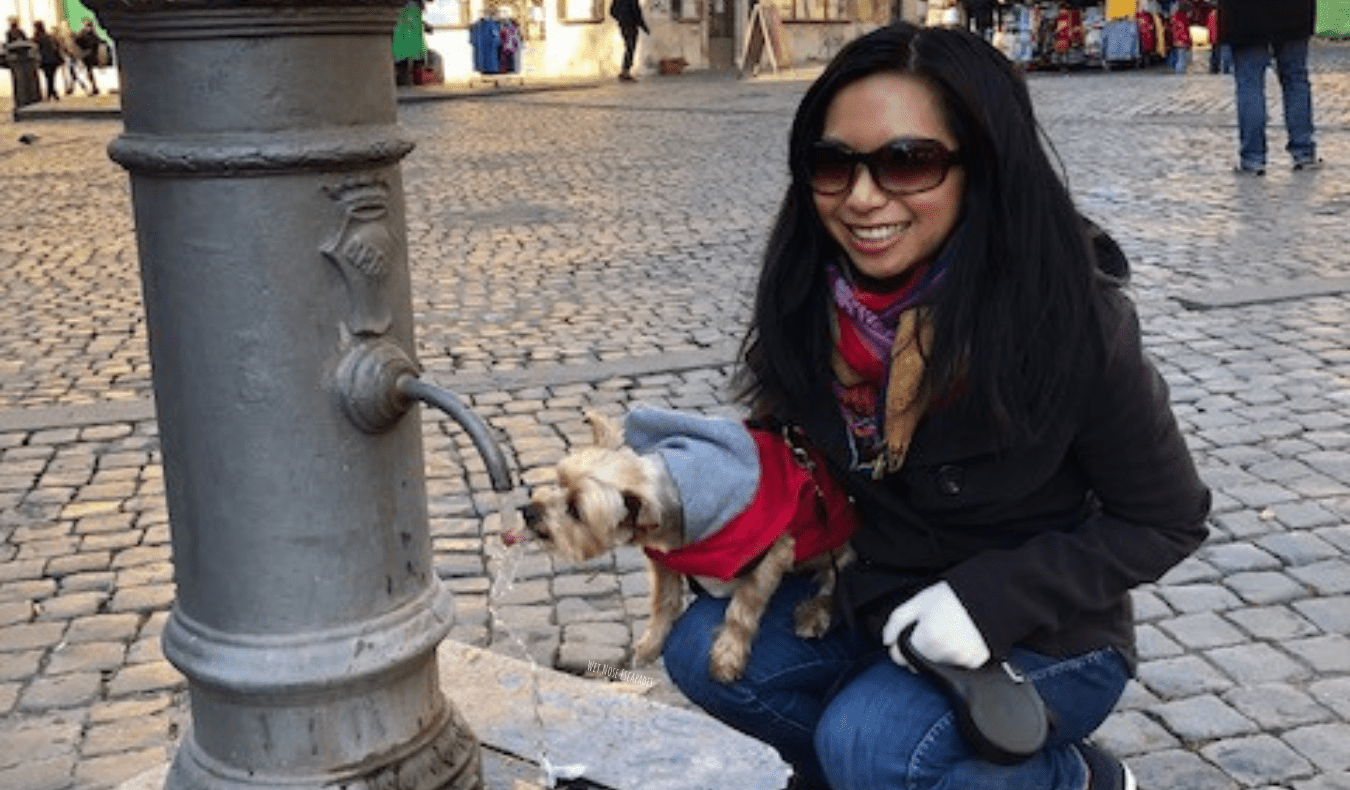
Posted : 10/27/22 | 27 October 2022
This is a guest post by Angelina (Gigi) Cho of Wet Nose Escapades on international dog travel. Over the past five years, he has flown more than 50 flights to more than 20 countries with Roger Wellington, a Yorkshire terrier. It's here to tell you what mistakes to avoid when traveling with your small backpack.
With the increase in the number of dog owners, many people are not only becoming dog parents, but also starting their own journey as dogs. According to the Society for the Prevention of Cruelty to Animals (ASPCA), more than 23 million American households (about one in five nationally) adopted pets during the outbreak. 37% of pet owners travel with their pets, compared to just 19% ten years ago. The US Department of Transportation says that more than two million pets travel by air each year.
This figure is expected to grow year on year as travel demand recovers after the pandemic. In addition to regular travel, many dogs are now flying planes for the first time. While it may seem tempting to take your child to a café in Paris or around the Luxembourg Gardens, the risks of traveling with them are high if not done correctly. Even if your dog lands safely at his destination, that doesn't mean the flight wasn't stressful or traumatic for him.
If you don't have a service animal, backyard flying is usually a gamble. Items that are too large to carry in the cabin (typically between 16 and 20 pounds, depending on the airline) must be carried as checked or checked baggage. Due to extremely hot or cold temperatures, poor ventilation, rough handling, and lack of supervision, animal welfare organizations such as the Humane Society and PETA generally recommend against transporting dogs in cargo. Therefore, flying in the cabin is always a safe option.
After traveling the world for more than five years weighing 7 kg. York Roger Wellington I understand that preparation is very important for any flight in the cabin. If you're planning a weekend getaway or vacation abroad, you should avoid these nine beginner mistakes when traveling with your pooch.
1. Not enough time for operator training

Carrier training is the most important part of flying your small dog. The goal is to help your pet feel comfortable and secure in the carrier before the flight. This step should not be neglected as it requires patience, time, and a lot of healing. You should spend at least two to three months in daily carrier training before your pet's first long-haul international flight and at least one month before a domestic flight. Otherwise, the journey may be hampered for the animal.
Daily repetition is essential for success. In the three months leading up to Roger V's first international flight to Paris, I spent at least 20 minutes every day making the airport the most interesting place in the world. I put his favorite toys and treats in the cart to get his attention.
I recommend starting little by little, that is, that your dog studies the carrier for a few minutes a day, and the third or fourth time close it little by little, entering voluntarily. Increase your training time each day with the goal of creating a safe rack space. Depending on the duration of the flight, you can make arrangements for your pet at least 1-3 hours before your departure date. The more comfortable your dog is in the carrier, the better it will handle the flight.
Get my advice on how to choose the best carrier for your small dog.
2. Do not study the requirements of the return flight
Most people planning a trip abroad with their dog focus on one-sided research on how to take their dog to Paris or Rome. They did some research to get back until it was time to go home.
If you don't move into permanent residence, you'll need to make sure you meet the requirements to bring your dog back to the United States, which may vary depending on where you're traveling with them. Your home state may have additional requirements.
For example, dogs entering New York State from outside the United States must have a certificate issued by a veterinarian (CVI) within 30 days or less of entry. The certificate must include records of rabies vaccinations for a period of one to three years.
It is important to understand that returning to the US depends on where your dog is. For example, there is a temporary ban until January 2023 for dogs imported from "high risk" countries with rabies (eg Brazil, Cuba, China, Russia, etc.). If you are trying to return to the US from such a category, your pet must have a CDC Dog Import Permit or a US issued rabies certificate and a compliant microchip certification with the ISO standard. You must also be at least six months old and healthy upon arrival (at any of the 18 designated airports at CDC quarantine stations).
To re-enter the United States from a country that does not have a high risk of rabies (eg, France, Belgium, Italy, United Kingdom, etc.), your dog may enter a port of entry with a history six-month trip. and a healthy port of entry. Appearance. . You must also be at least six months old, be microchipped, and have a valid CDC dog import permit or U.S.-issued rabies vaccination certificate.
If you are traveling with your dog in Europe, you should be aware that some countries are considered "high" risk countries for rabies (eg Montenegro). This means that your pet must undergo a titration test before returning to a "rabies-controlled" EU country.
You can learn more about USDA APHIS to find out exactly what requirements you must meet.
In addition to rabies regulations, there are special requirements if you are returning to the United States from a country that is not free of FMD.
3. Take your dog's first international flight
Long-haul flights are hard on everyone, and your furry little traveler is no different. No matter how confident you are in your little ability to travel around the world, your first flying experience shouldn't be a long-haul international flight. For your dog's sake, it's a good idea to take at least one domestic flight before traveling abroad. I drove Roger W on four flights from San Francisco to Los Angeles (and back) and from California to New York before embarking on a 10+ hour flight from Los Angeles to Paris.
Unlike humans, dogs don't know where they're going or how long they'll be on the plane. So the more you expose your pooch to flights, the better he'll feel about a big (long) day of travel.
Also, your pet will need to be familiar not only with air traffic, but also with the general environment of the airport. For example, you can help your little dog learn about airplane noise, airport noise, crowds, TSA checkpoints, and boarding processes. In general, familiarity creates comfort.
4. Book flights with more than one duration
While it's tempting to save money by choosing a route with multiple flights, you should fly with as much of your wallet as possible. However, they had no idea where they were going or how long it would take to get there. Even seemingly quick breaks can put extra stress on your dog's small body, making for a long ride. If multiple flights cannot be avoided, you should give your pet some much-needed rest by staying a few days to a week before taking the next flight.
I am often asked which is better: the long flight or the short flight. My main rule of thumb is that if the flight is longer than 11-12 hours, I recommend splitting the travel days. The shorter the trip, the easier it will be for your dog. A few days of rest will help you recover and gain energy for the next day's journey. Also, the two will explore different places before reaching their final destination!
5. Without draining your dog's energy

Before flying, it is important to train your pet to burn off his energy. As the old saying goes, a tired dog is a happy dog! Get into the habit of walking before each flight to ensure a smooth and comfortable ride. The key here is not to force your dog into strenuous physical activity, but simply to add an extra 15 to 20 minutes of exercise to help him sleep during the flight. The longer you can sleep on the plane, the smoother the trip will be.
However, before you extend the time, consider your dog's general health and weather conditions: Of course, an extra 15 minutes in extreme heat or cold should not be tolerated.
For long haul flights I always make sure Roger W is relaxed before leaving for the airport. Walking is usually 45 minutes, so I extended it to 60 minutes to make it a bit strenuous. When I arrive at the airport, I walk him through the open space and take him to an outdoor pet grooming area, if available. You can find pet-friendly areas at US airports here.
After checking into the rack for our flight, I pulled it out one last time. While many airports now have pet areas in the terminals, Roger W. prefers the artificial grass found in most pet holding areas. If your dog is okay with the artificial turf (which usually has a different concentration of urine), he may not need to go outside again.
6. Not systematic with the intake of water and food.
In the world of air travel, people have very little tolerance for well-behaved dogs, especially accidents. No one wants to sit next to a dog (even a small dog) that wets the bed (as if barking). So avoid risks by planning meal times before and during the flight, food and water portions, and bathroom breaks. Never fly a dog on a full or empty stomach; The ideal time to eat should be about two hours before going to the airport to give time for digestion and rest.
Depending on cabin temperature, every 3-4 hours on long-haul flights (seven hours or more) and every two hours on short-haul flights (less than seven hours) for Roger V needs. I also prefer to eat snacks or small meals throughout the flight to avoid accidents and make sure you eat enough. If the flight is less than four hours, I only give it as a reward for good behavior and save food until landing. The longer the flight, the more water and food to consider.
7. Not being prepared for accidents
As mentioned above, messy dogs are no fun and the last thing you want to do is find things to clean up after your pet. No matter how well-trained your little dog is, accidents can still happen in new environments, especially stressful ones.
Despite months spent in carrier training, accidents can still happen when dogs try to "catch" as many as possible so they don't soil their bedding. Whether you're walking your dog through the terminal or flying at 35,000 feet, you must have a bag, pee pad, dog wipes, and hand wipes so you can quickly clean up your dog with no hassle. Keep these essentials in an easily accessible place in your personal belongings or wallet.
Remember to show compassion when taking your dog for a walk because he has been cuddled for a long time or is uncomfortable in unfamiliar surroundings. Don't make a fuss or yell at him: clean up quickly and move on (plus, dogs learn better with positive reinforcement).
Also: Be reasonable! After a 10-hour flight, do you expect your dog to "hold" you until you leave the airport or be cared for? A four-hour flight may not be that long, but it can easily add up to seven hours when you factor in pre-flight check-in, TSA check-in, boarding, and disembarkation. In over five years of travel, Roger W has never been in a plane crash, but in any case, I'm up for a quick and easy cleanup.
8. Show off your dog

While you may find many travelers who love dogs, you may find your little four-legged traveler indifferent, fearful, or disgusted by others. While it may be unpleasant to admit, you shouldn't assume that everyone likes or is comfortable with a dog. Respect people who fear or dislike you, who feel uncomfortable, or who have allergies.
Always stay crouched unless you scan the room. Don't brag about your puppy; You don't want unhappy passengers complaining about your pet's behavior or presence. The less attention, the better.
Again, passengers or airline staff rarely tolerate a "behaved" dog. Unfortunately, even those who kick and yell at babies have a better chance than calm, well-behaved balloon dogs. Most of the passengers didn't even realize he had a dog until it was time to disembark, which clearly shows how well behaved Roger W is in public.
Instead of getting into needless verbal fights with dog-hating passengers, it's better to ignore them and make sure your pets are well-behaved at everything from airline check-in to check-in to baggage claim.
When traveling through the airport, keep your pet on a leash or carrier and keep them away from other people. Even at Los Angeles International Airport, we have met young families from other cultures; Children ran past us screaming.
9. Do not follow the dog during the flight
While you may feel relaxed as soon as your pet boards the plane, the real journey is just beginning. Lots of things can go wrong in the air, from comfort to ventilation issues to accidents. Whether it's a perfectly healthy puppy or an older dog (like Roger W), you need to keep an eye on him and keep him awake as much as possible.
Even if your backpack snores on its back with all four palms in the air, don't go completely sideways in an emergency. Turn down the volume on your headphones and keep checking on your dog on the plane.
Shortly after taking off from Madrid for Geneva, Roger W began to have difficulty breathing due to the unusually congested plane. I immediately opened the airline so he could get more air, but he got in trouble with the stewardess for breaking the rules. But no flight is worth my dog's life, I'm determined to win. I begged the two flight attendants for 15 minutes before they finally let us out by ourselves.
Traveling with Roger W has not only strengthened our relationship, it has also allowed me to make new connections and lasting friendships around the world. He brought a more "local" experience and took me places I wouldn't have gone without my dog.
With so many dog-friendly airlines, hotels, and businesses, traveling with your small bag has never been easier. As long as you put your health, comfort, and safety first, you can have some amazing hiking experiences together.
In Since quitting her full-time job in 2016, Angelina (Gigi) Chow has been living a life of travel with Roger Wellington from York. He is the creator of Wet Nose Escapades, the international dog travel blog narrated by Roger W. He is also the author of How to Travel With Your Dog: Roger Wellington's Expert Guide to International Dog Travel. Follow his journey on YouTube, Instagram, Facebook and Twitter.
Book a trip: logistics tips and advice
I booked a flight.
Find cheap flights with Skyscanner. This is my favorite search system, as it searches websites and airlines all over the world, so you always know that no business need is missed.
open this
You can book hostels on Hostelworld. али ественный атьтца е ернаце, а есяце, use Booking.com, о он он е анный а ансиянаты ересный.
Don't forget about travel insurance
Travel insurance will protect you from illness, injury, theft, and fraud. It's a complex defense if things go wrong. I have used it so many times in the past that I never travel without it. Here are my favorite companies that offer the best service and rates:
- SafetyWing (the best for everyone)
- Your travel insurance (for people over 70 years old)
- Medjet (for additional evacuation coverage)
Ready to book a trip?
Check out my resource page for information on the best companies you can use on the go. ераличваю е, азываюся during the trip. They are the best in their class and you won't forget them while traveling.
Post 9 mistakes to avoid when traveling with small dogs

